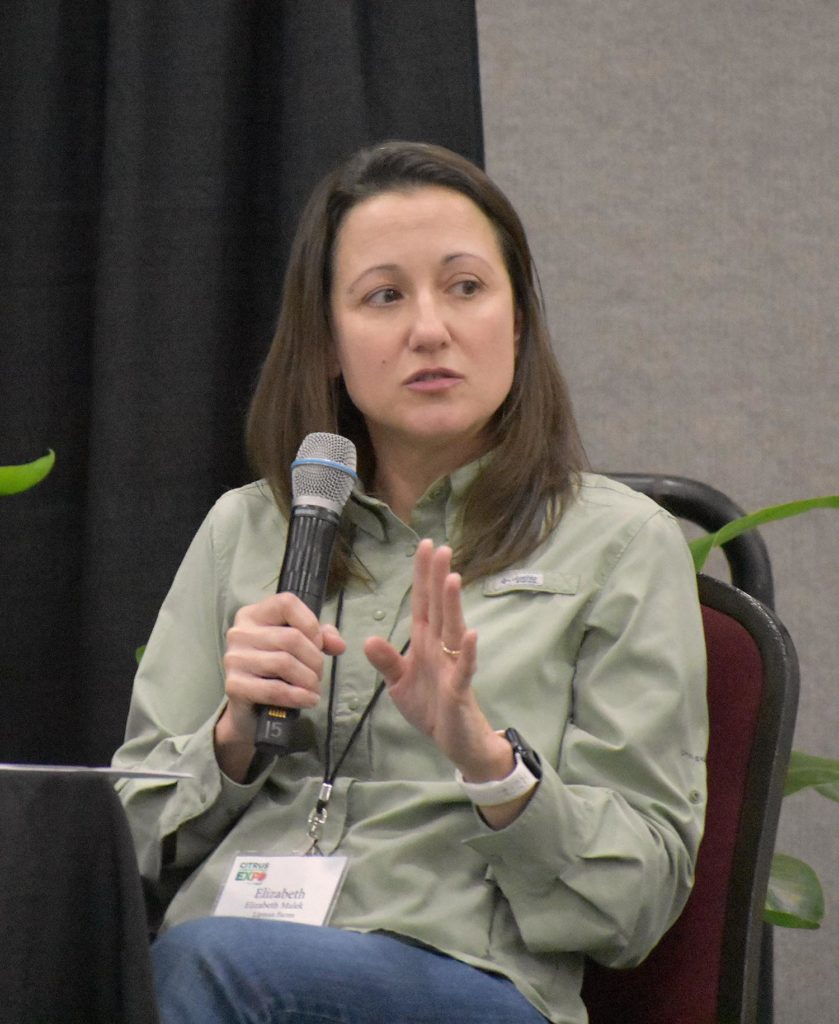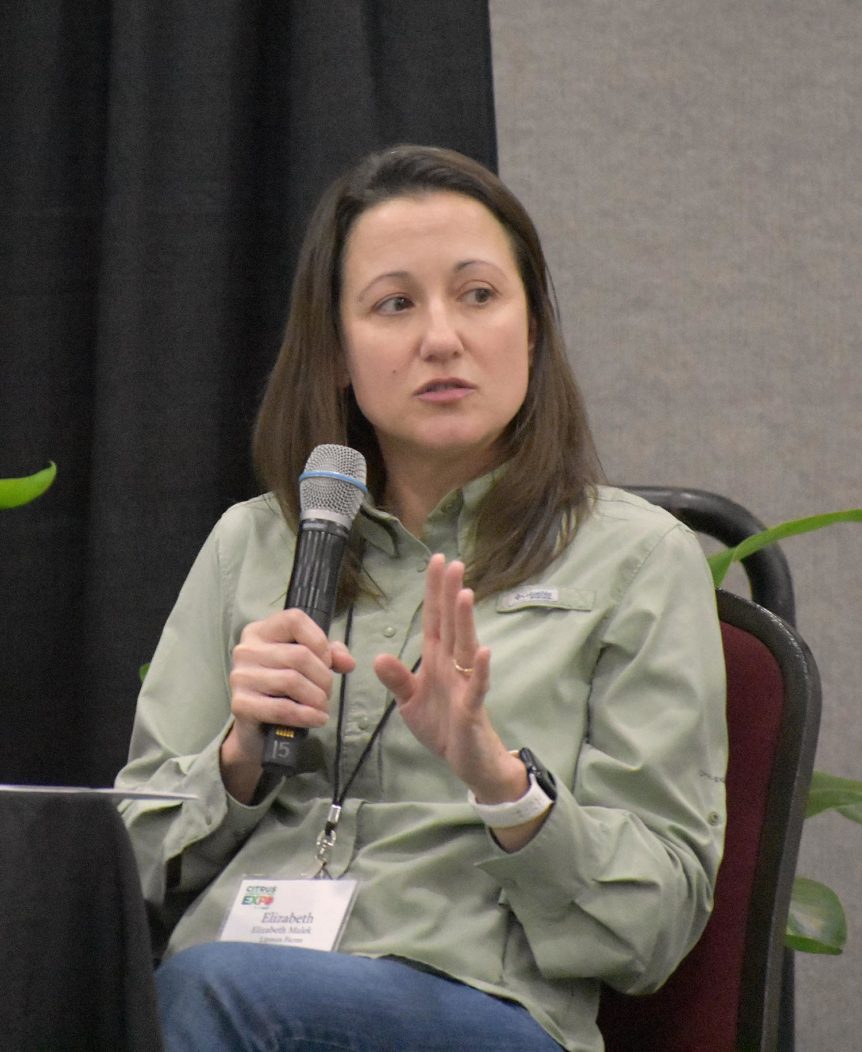
By Frank Giles, Tacy Callies and Clint Thompson
This year’s Citrus & Specialty Crop Expo in Tampa provided an extensive seminar program and various opportunities for growers to network with their peers. Educational programming focused on industry issues, citrus production, specialty crops and alternative crops.
General Session
The event’s general session touched on various topics like the farm economy, labor issues, ag funding and more. American Farm Bureau economist Danny Munch noted the overall farm economy faces some headwinds going into the coming year with trade imbalances and farm income being chief among them.
In a panel discussion, Jamie Fussell, director of labor relations for the Florida Fruit & Vegetable Association, spoke on some recent wins on the labor front. This includes the suspension of the H-2A Worker Protection Rule, which added more regulation and red tape to the program.
Also participating in the panel was Matt Joyner, executive vice president and chief executive officer of Florida Citrus Mutual. He discussed the growing sense of optimism among citrus growers that recent therapies and an influx of funding for the Citrus Research and Field Trial (CRAFT) Foundation are helping to turn the industry in a more positive direction against HLB.

Retired New York City Fire Department Battalion Commander Jack Oehm gave a special presentation recounting his experiences on the ground during and after 9/11. He also discussed his current role as an ambassador for the Tunnel to Towers Foundation.
CITRUS SEMINARS
The citrus seminar program included more than 20 talks over two days. The sessions began with an update from Steven Hall, CRAFT Foundation executive director. Hall discussed the different CRAFT programs growers can apply to. CRAFT recently received record funding of more than $100 million from the Florida Legislature. The programs provide payments to growers for new plantings as well as studies conducted in existing groves. The foundation had already issued 20 contracts to growers in the first two weeks of the application cycle that opened in early August. Growers can apply for funding at craftfdn.org until Oct. 3.
University of Florida Institute of Food and Agricultural Sciences (UF/IFAS) researchers delivered the remaining citrus presentations. Several were focused on HLB.
Presentations were given on the search for citrus trees that have tolerance or resistance to HLB, whether through conventional breeding or techniques like gene editing.
Trunk injection of oxytetracycline (OTC) remains a primary treatment for managing HLB in Florida groves. Ute Albrecht presented best practices for OTC application. She advised growers to acidify OTC solutions correctly (pH 2) and to apply them promptly, so they do not lose efficacy. The solution should be yellow, not brown or red. Higher OTC rates usually perform better, but both commercially available OTC formulations showed the same efficacy in her trials. She recommended combining OTC injections with other practices, like individual protective covers.
Survey Highlights
Tara Wade presented results from her Florida grower survey on OTC adoption and outcomes. Highlights from her findings were as follows:
· OTC was adopted by 79% of growers surveyed on 94% of their acres.
· Almost 90% of growers see improved yields and decreased fruit drop with OTC.
· Pound solids increased by 15% to 25% for most growers.
· Sixty percent of growers think OTC adoption is risky.
Citrus nutrition continues to be the cornerstone of HLB mitigation programs. Davie Kadyampakeni’s talk detailed the five Rs of citrus production in the era of HLB:
1. Right water management – Use of soil moisture sensors and daily irrigation is encouraged. But in the case of ½ inch or greater rainfall, avoid irrigation for two days.
2. Right nutrient rate – Apply nitrogen at 180 to 200 pounds per acre.
3. Right fertilizer placement – Place fertilizer in the irrigated zone or where the microjet wetting pattern is.
4. Right fertilizer source – Improved fertilizer blends resulted in better root growth efficiency and higher fruit yields.
5. Right timing – Annual application rates: Slow-release or controlled-release fertilizer two to three times, conventional granular fertilizer in four splits, and foliar fertilizer three to four times.
Specialty and Alternative Crops
Seminars dedicated to vegetable and small fruit growers tackled some of the key pests growers fight in multiple crops. Several of these talks were presented as panel discussions that included academia, consultants and growers. They addressed whitefly, Thrips parvispinus and chilli thrips. The panelists agreed that all these pests are becoming more problematic to control and require diligence in monitoring and management.
Frank Giles, AgNet Media editor-in-chief, also had one-on-one conversations with UF/IFAS weed scientist Nathan Boyd about key weed pests and with UF/IFAS plant pathologist Gary Vallad on prominent diseases in vegetables.
Another session focused on potential alternative crops, including bamboo, which is gaining renewed interest. Michael Rogers, UF/IFAS Citrus Research and Education Center director, discussed bamboo and its viability in Florida. Its value is mostly due to the plethora of uses it can be produced for.
“There is a big market for bamboo products, not only finished products but also raw products. We’re talking about bamboo shoots and poles. There are a lot of uses for those here in Florida. For the poles, we’re talking about things like timber as a replacement for pine trees,” Rogers said.
Other potential crops include macadamia, though infrastructure is needed to scale production; and tropical fruits, which have extended their reach into Central Florida due to climate change. Lychee is now being recommended for Central Florida production because it is too hot to grow in South Florida.










